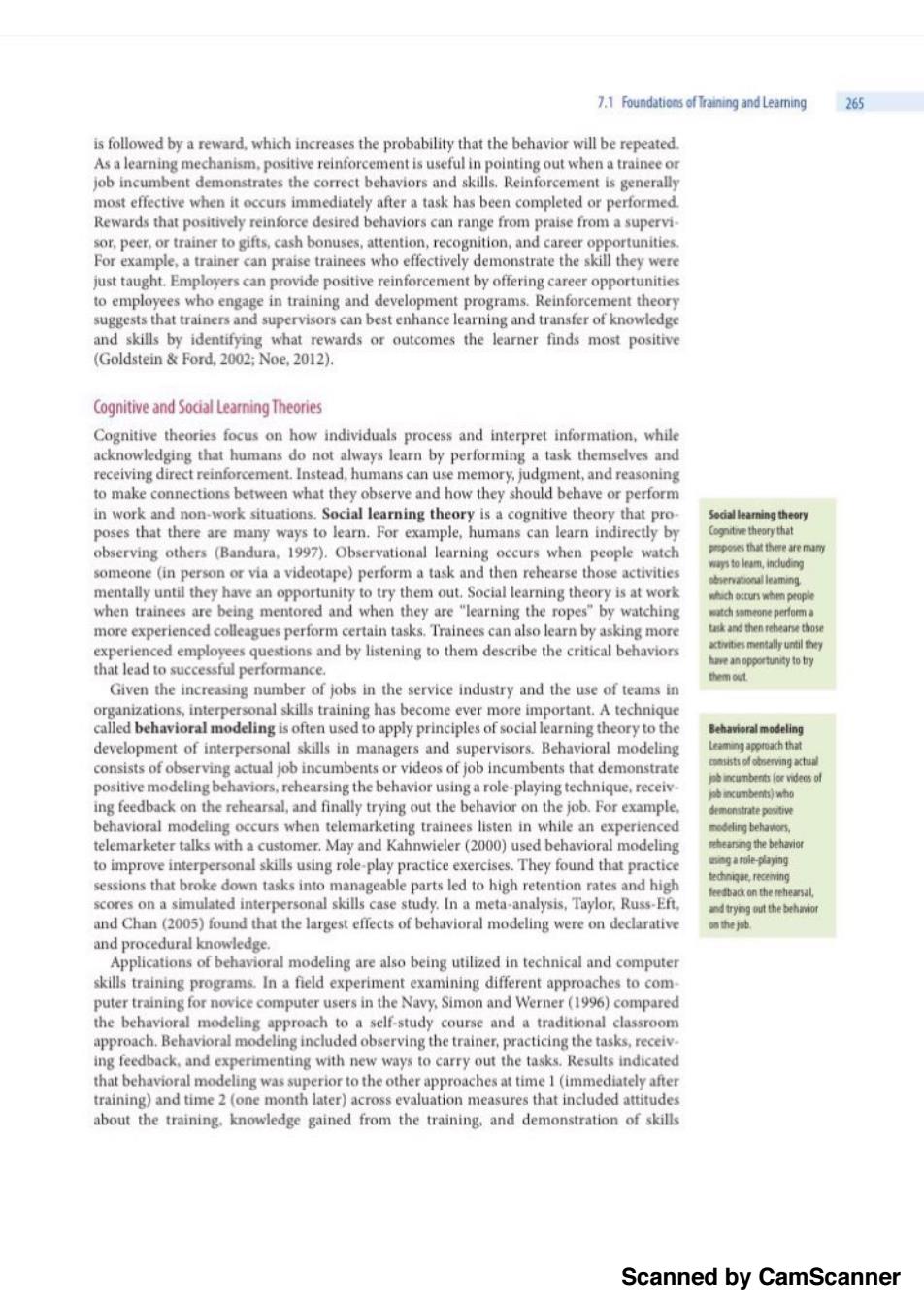正在加载图片...

7.1 Foundations of Training and Leaming 265 is followed by a reward,which increases the probability that the behavior will be repeated. As a learning mechanism.positive reinforcement is useful in pointing out when a trainee or job incumbent demonstrates the correct behaviors and skills.Reinforcement is generally most effective when it occurs immediately after a task has been completed or performed. Rewards that positively reinforce desired behaviors can range from praise from a supervi- sor,peer,or trainer to gifts,cash bonuses,attention,recognition,and career opportunities. For example,a trainer can praise trainees who effectively demonstrate the skill they were just taught.Employers can provide positive reinforcement by offering career opportunities to employees who engage in training and development programs.Reinforcement theory suggests that trainers and supervisors can best enhance learning and transfer of knowledge and skills by identifying what rewards or outcomes the learner finds most positive (Goldstein Ford,2002:Noe.2012). Cognitive and Social Learning Theories Cognitive theories focus on how individuals process and interpret information,while acknowledging that humans do not always learn by performing a task themselves and receiving direct reinforcement.Instead,humans can use memory,judgment,and reasoning to make connections between what they observe and how they should behave or perform in work and non-work situations.Social learning theory is a cognitive theory that pro- Socal learning theory poses that there are many ways to learn.For example,humans can learn indirectly by Cognitive theory that observing others (Bandura,1997).Observational learning occurs when people watch poves that there ar单mu间 ways to leam,induding someone (in person or via a videotape)perform a task and then rehearse those activities bervational leaming mentally until they have an opportunity to try them out.Social learning theory is at work whch otrurs whmn prople when trainees are being mentored and when they are "learning the ropes"by watching tch sumeone perform。 more experienced colleagues perform certain tasks.Trainees can also learn by asking more task and then rehearse those experienced employees questions and by listening to them describe the critical behaviors activities menta与y that lead to successful performance. have an opportunity to by them out. Given the increasing number of jobs in the service industry and the use of teams in organizations,interpersonal skills training has become ever more important.A technique called behavioral modeling is often used to apply principles of social learning theory to the Behavioral modeling development of interpersonal skills in managers and supervisors.Behavioral modeling Leaming approach that consists of observing actual job incumbents or videos of job incumbents that demonstrate positive modeling behaviors,rehearsing the behavior using a role-playing technique,receiv. 地umbents)who ing feedback on the rehearsal,and finally trying out the behavior on the job.For example. monstrate pesitiv behavioral modeling occurs when telemarketing trainees listen in while an experienced medeing behavors. telemarketer talks with a customer.May and Kahnwieler(2000)used behavioral modeling eang the behavior to improve interpersonal skills using role-play practice exercises.They found that practice g的g technigue,receiving sessions that broke down tasks into manageable parts led to high retention rates and high feedback on the rehearsal. scores on a simulated interpersonal skills case study.In a meta-analysis,Taylor,Russ-Eft, n时yng out the树hio and Chan (2005)found that the largest effects of behavioral modeling were on declarative 第he and procedural knowledge. Applications of behavioral modeling are also being utilized in technical and computer skills training programs.In a field experiment examining different approaches to com. puter training for novice computer users in the Navy,Simon and Werner (1996)compared the behavioral modeling approach to a self-study course and a traditional classroom approach.Behavioral modeling included observing the trainer,practicing the tasks,receiv. ing feedback,and experimenting with new ways to carry out the tasks.Results indicated that behavioral modeling was superior to the other approaches at time 1(immediately after training)and time 2 (one month later)across evaluation measures that included attitudes about the training.knowledge gained from the training,and demonstration of skills Scanned by CamScannerScanned by CamScanner